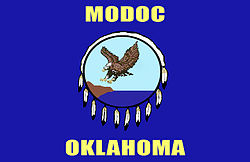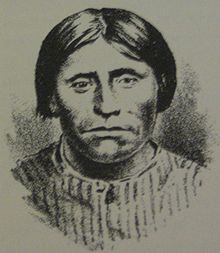- Modoc Tribe of Oklahoma
-
Modoc Total population 200[1] Regions with significant populations  United States (
United States ( Oklahoma)
Oklahoma)Languages Religion Christianity (Quaker), traditional tribal religion
Related ethnic groups other Modoc people, Klamath, Yahooskin
The Modoc Tribe of Oklahoma is the smallest federally recognized tribe in Oklahoma.[2] They are descendants of Captain Jack's band of Modoc people, removed from the West Coast after the Modoc Wars.
Contents
Early history
The traditional homelands of the Modoc people are on the California-Oregon border, bounded by the Cascade Mountains on the north and the Lava Beds on the south. They hunted, fished, and gathered wild plants for foods. While the Modoc are commonly regarded as relatives of the Klamath people, Modoc tribal historian, Patricia Scruggs writes that for 10,000 years the Modoc were "a culturally detached and unique band," and the Klamath were in fact the Modoc's traditional enemies.[3]
The tribe spoke the Klamath-Modoc language, which no longer spoken by living Modocs.[4] Their name for themselves is Maklaks or "people."[2]
Significant contact with European-Americans did not occur until the early 19th century. Fur traders introduced firearms and horses to the Modoc. They were rapidly followed by an overwhelming influx of gold prospectors and ranchers, who arrive in Modoc country via the Oregon Trail. Initially the Modocs tried to accommodate the settlers, but their demand for land became too much, and the Modoc, the Klamath, and the Yahooskin Band of Snake Indians signed a treaty with the US government in 1864, establishing a joint reservation in Oregon.[3]
Modoc War and removal
The Indian Agent assigned to the Modoc utterly neglected his duties to the tribe. The Klamath routinely harassed the Modoc as well. These troubles and the problem inherent to the reservation existence led Captain Jack in 1865 to lead his band of Modocs back to their ancestral homeland near Lost River in California. They stayed there for two years, demanding a separate Modoc Reservation.[3]
The US Army became determined to return Captain Jack's band, known as the "Hot Creeks," to Oregon and a force of 1000 men against them, initiating the Modoc War. Captain Jack only had 57 warriors in his band, but they fought off the US Army for almost six months. They were assisted by their spiritual leader, Curley Headed Doctor.[5] Captain Jack lost only six men in combat, while the US Army lost 45, including E. R. S. Canby, who is the only general slain in an Indian War. The Modoc War is considering one of the costliest Indian Wars fought by the US, who spent at the bare minimum a half a million dollars, to subdue the Modocs.[3]
The war came to end on June 1, 1873. Modoc warriors, Captain Jack, Barncho, Black Jim, Boston Charley, Schonchin John, and Slolux became the only Indians in US history to be tried for war crimes by a military commission. Before the trial even began, gallows were constructed. All but Barncho and Slolux were condemned to death by hanging. The two were given life sentences in Alcatraz, but were forced, as were all the Modocs, including women and children, to watch the other three men's execution.[3]
The remaining 155 Modoc were transported to Fort Klamath, Oregon in 1873. Without being informed of their destination, the tribe was shipped to the Quapaw Agency in Kansas in freezing cattle cars, guarded at gunpoint. After confused deliberation, government agents purchased 4,000 acres (16 km2) from the Eastern Shawnee to provide a new reservation for the Modoc in Indian Territory.[3]
They arrived in December and no funds or supplied were available to the tribe for an entire year. Disease took its toll and the Indian Agent assigned to them, Hiram W. Jones was both cruel and corrupt. Their chief, Scarface Charley, was replaced by one appointed by Agent Jones, Bogus Charley, who governed the tribe until 1900.[3]
Despite incredible hardship, the Modoc people survived. They worked at any jobs available and sold beadwork and basketry. Patricia Scruggs writes, "[T]hey sowed and reaped with the same persistent courage with which they had fought." In time the living conditions of the Modoc surpassed those of their European-American neighbors.[3]
20th century
In 1909, the US government allowed any Oklahoma Modocs that wanted to, to return to Oregon. 29 made the move.[3] The Modoc of Oregon became part of the Klamath Tribes Confederation.
In the mid-20th century the tribes of the northeastern corner of Oklahoma in banded together, forming the Northeast Eight Inter-Tribal Council. They include the Eastern Shawnee Tribe of Oklahoma, the Miami Tribe of Oklahoma, the Modoc Tribe of Oklahoma, the Ottawa Tribe of Oklahoma, Peoria Tribe of Indians of Oklahoma, Quapaw Tribe of Indians, Oklahoma, Seneca-Cayuga Tribe of Oklahoma, and the Wyandotte Nation.
The tribal government was gutted by the US Curtis Act of 1898. It was not until 1978 that the tribe was able to reorganize under the Oklahoma Indian Welfare Act, as the Modoc Tribe of Oklahoma. Upon achieving federal recognition, the tribe purchased and restored Modoc Friends Church and Cemetery, a tribally-built Quaker church.[3]
Today
The Modoc Tribe of Oklahoma is headquartered in Miami, Oklahoma. Of the 200 enrolled tribal members, 120 live within the state of Oklahoma. The tribe's Chief is Bill Follis, who was instrumental in securing federal recognition.[3] The Modoc tribal jurisdictional area falls within Ottawa County, Oklahoma.[1]
The Oklahoma Modocs operate their own housing authority, one casino, a tribal smoke shop, Red Cedar Recycling, Modoc Buffalo Project, and Modoc Flooring. They also issue their own tribal license plates.[1] The Modoc Tribe jointly operates its casino, The Stables, with the Miami Tribe of Oklahoma. The casino is located in Miami, Oklahoma, and includes a restaurant, gift shop, and hotel.[6]
Tribally-owned Red Cedar Recycling provides free cardboard and paper recycling for area businesses and residents and pays market rate for aluminum to recycle. The tribal company also provides educational materials about recycling and hosts tire recycling events.[7]
Notes
- ^ a b c "Pocket Pictorial." Oklahoma Indian Affairs Commission. 2010: 22. . Retrieved 10 June 2010.
- ^ a b Self, Burl E. Modoc. Oklahoma Historical Society's Encyclopedia of Oklahoma History & Culture. 2009 (10 Feb 2009)
- ^ a b c d e f g h i j k Scruggs, Patrica. The History of the Modoc Tribe of Oklahoma. 2009 (10 Feb 2009)
- ^ Anderton, Alice, PhD. Status of Indian Languages in Oklahoma. Intertribal Wordpath Society. 2009 (10 Feb 2009).
- ^ Thrapp, Dan L. Encyclopedia of Frontier Biography, Volume 1: A-F. Lincoln: University of Nebraska Press, 1991.
- ^ The Stables. 2009 (10 Feb 2009)
- ^ Red Cedar Recycling. Modoc Tribe Office of Environmental Quality.
External links
Native American tribes in Oklahoma Federally
recognized
tribesAbsentee-Shawnee Tribe of Indians of Oklahoma · Alabama-Quassarte Tribal Town · Apache Tribe of Oklahoma · Caddo Nation of Oklahoma · Cherokee Nation · Cheyenne and Arapaho Tribes · Chickasaw Nation · Choctaw Nation of Oklahoma · Citizen Potawatomi Nation · Comanche Nation · Delaware Nation · Delaware Tribe of Indians · Eastern Shawnee Tribe of Oklahoma · Fort Sill Apache Tribe of Oklahoma · Iowa Tribe of Oklahoma · Kaw Nation · Kialegee Tribal Town · Kickapoo Tribe of Oklahoma · Kiowa Indian Tribe of Oklahoma · Miami Tribe of Oklahoma · Modoc Tribe of Oklahoma · Muscogee Creek Nation · Osage Tribe · Otoe-Missouria Tribe of Indians · Ottawa Tribe of Oklahoma · Pawnee Nation of Oklahoma · Peoria Tribe of Indians of Oklahoma · Ponca Tribe of Indians of Oklahoma · Quapaw Tribe of Indians · Sac and Fox Nation · Seminole Nation of Oklahoma · Seneca-Cayuga Tribe of Oklahoma · Shawnee Tribe · Thlopthlocco Tribal Town · Tonkawa Tribe of Indians of Oklahoma · United Keetoowah Band of Cherokee Indians in Oklahoma · Wichita and Affiliated Tribes · Wyandotte NationTribal languages
(still spoken)Alabama · Arapaho · Caddo · Cayuga · Cherokee · Cheyenne · Chickasaw · Chiwere (Iowa and Otoe) · Choctaw · Comanche · Delaware · Koasati · Hitchiti-Mikasuki · Mescalero-Chiricahua · Mesquakie (Fox, Kickapoo, and Sauk) · Muscogee · Osage · Ottawa · Pawnee · Ponca · Potawatomi · Quapaw · Seneca · Shawnee · Wichita · Wyandot · YuchiCategories:- Native American tribes
- Native American tribes in Oklahoma
- Indigenous peoples in the United States
- Native American tribes in California
- Modoc tribe
- Federally recognized tribes in the United States
Wikimedia Foundation. 2010.



